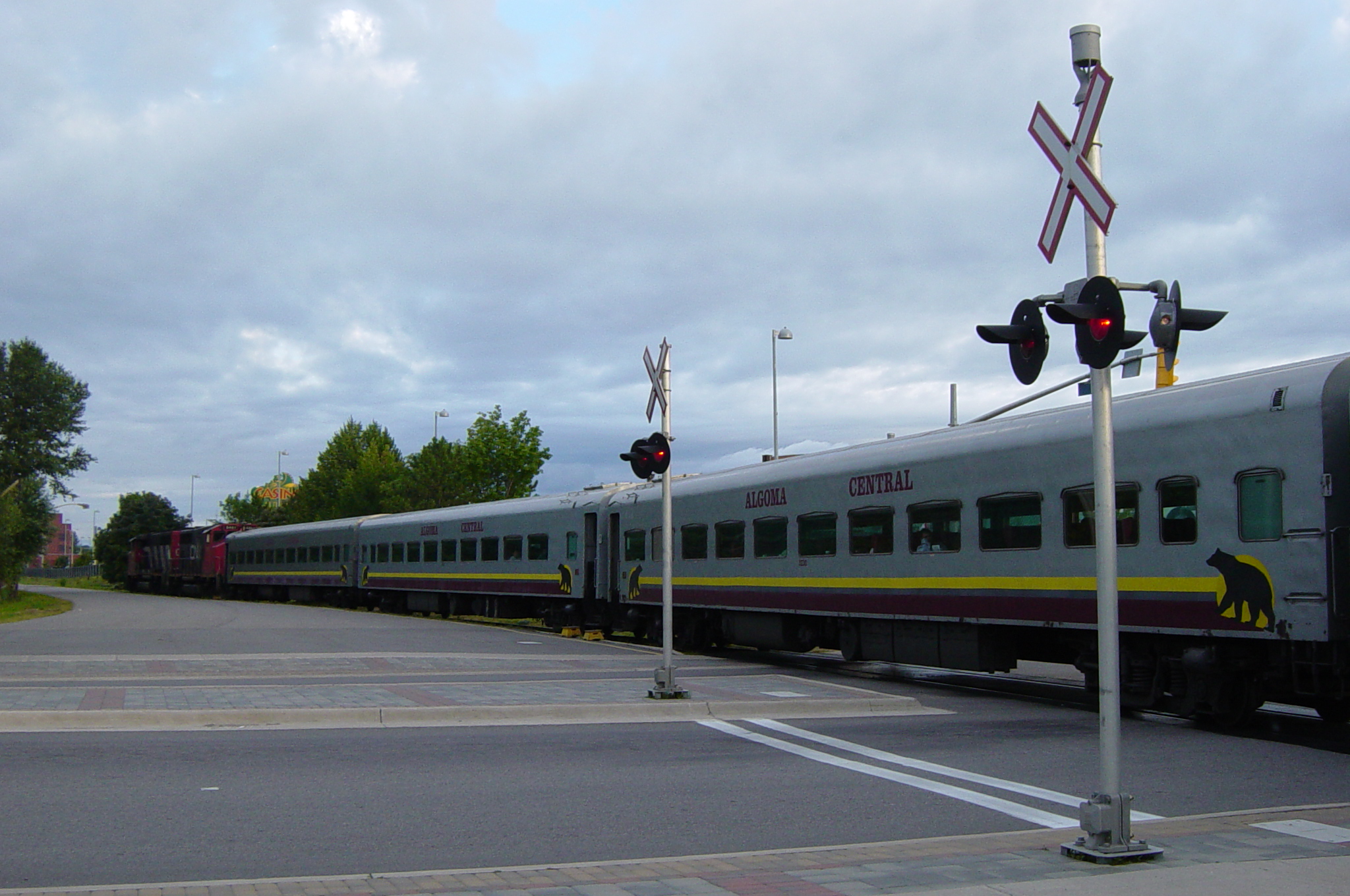- Algoma Central Railway
Infobox rail
railroad_name = Algoma Central Railway
logo_filename =
logo_size =
system_
map_caption =
map_size =
marks = AC, ACIS

image_size =
image_caption = The Algoma Central Railway's popularAgawa Canyon Tour Train
locale =Northern Ontario
start_year = 1899
end_year = 2001
predecessor_line =
successor_line =Canadian National Railway
gauge = RailGauge|ussg
length =
hq_city = Sault Ste. Marie,Ontario The Algoma Central Railway (AAR
reporting mark s AC, ACIS) was arailway inNorthern Ontario that ran between Sault Ste. Marie and Hearst, with a branch line to Michipicoten. The area served by the railway is sparsely populated, with fewroad s. The railway is well known for itsAgawa Canyon tour train. The railway was purchased byWisconsin Central Transportation in 1995, which was in turn purchased byCanadian National Railway in 2001. It is now operated as part of CN's Eastern Division.History
The Algoma Central Railway was initially owned by Francis H. Clergue, who required a railway to haul resources from the interior of the Algoma District to Clergue's industries in Sault Ste. Marie; specifically, to transport logs to his
pulp mill andiron ore from the Helen Mine near Wawa to a proposedsteel mill (which was later namedAlgoma Steel ). The Algoma Central Railway was chartered onAugust 11 ,1899 . cite book
last = Wilson
first = Dale
title = The Algoma Central Railway Story
publisher = Nickel Belt Rails
date = 1984
location = Sudbury, Ontario
id = ISBN 0-920356-05-2] The railway's Dominion and provincial charters gave it authority to build north from Sault Ste. Marie to a junction with theCanadian Pacific Railway 's main line, as well as a branch line to Michipicoten Harbour, onLake Superior near Wawa.In 1901 Clergue acquired the charter of the Ontario, Hudson Bay and Western Railway, who were intending to build a line between the CPR main line and
Hudson Bay and then changed the name of the Algoma Central Railway to The Algoma Central and Hudson Bay Railway Company, anticipating a connection either to Moose Factory onJames Bay , or to some point on Hudson Bay.The Algoma Central fell victim to the bankruptcy of Clergue's
Consolidated Lake Superior Corporation in 1903. At that time, the line reached 90 km (56 miles) north of Sault Ste. Marie with a 32-km (20-mile) segment running east from Michipicoten Harbour that did not yet connect with the main line. Construction was stopped, but was resumed in 1909 and the line was extended northward through to junctions with the Michipicoten Harbour branch (at Hawk Junction), the Canadian Pacific Railway (at Franz) and theCanadian Northern Railway (at Oba). In 1914 it finally reached Hearst, a town 476 km (296 miles) north of Sault Ste. Marie that was adivisional point on theNational Transcontinental Railway . By that point, Clergue's dream of building a railway to Hudson Bay or James Bay had long been abandoned, and the railway's northern terminus remained at Hearst, around 240 km (150 miles) from James Bay. However, the phrase "and Hudson Bay" was not removed from the railway's name untilJune 30 ,1965 .The Algoma Central was the first Canadian railway to fully dieselize, in 1952. cite web
last = Boldt
first = Hans
coauthors = S. Grisonich-Boldt
title = Algoma Central Railway
url = http://www.boldts.net/Sault4.shtml
accessdate = 2006-12-15]In the 1960s, the railway began to promote the natural beauty of the District of Algoma to
tourist s, especially theAgawa Canyon , a canyon around theAgawa River , 114 rail miles (183 km) north of Sault Ste. Marie that is not accessible by road. [cite web
title = Algoma Central Railway FAQ
publisher =Canadian National Railway
url = http://www.agawacanyontourtrain.com/content/general/faq.html
accessdate = 2006-12-15] The Algoma Central developed a tourist stopover here, which was a great success for the railway. Owing to the popularity of the Agawa Canyon excursions, the Algoma Central would run the longestpassenger train s inNorth America , often up to 20 to 24 cars long. During the 1970s and 1980s around 100,000 people per year would tour Agawa Canyon.The railway had been in the
shipping business since 1900, when it had purchased foursteamship s. Starting around the 1960s, the railway greatly expanded its marine operations and diversified intotrucking ,real estate ,forestry , andmining operations. These operations were more profitable than the railway operations, and onApril 30 ,1990 , as part of a corporate reorganization, the name of the company was changed toAlgoma Central Corporation , and the Algoma Central Railway became a subsidiary of it. [cite journal
title = Algoma changes its name to inform investors it's more than a railway
journal =Northern Ontario Business
volume = 10
issue = 9
pages = 16
publisher =Laurentian Publishing
date =1990-06-01 ] A few years later the Algoma Central Railway was put up for sale. OnFebruary 1 ,1995 , Wisconsin Central Ltd. purchased Algoma Central Railway Incorporated, operating the railway as a separatesubsidiary , Wisconsin Central Canada Holdings. In 1998, Algoma Steel closed its iron ore mine in Wawa, and the branch line between Michipicoten Harbour and Hawk Junction was abandoned. Wisconsin Central Ltd. was acquired by Canadian National onOctober 9 ,2001 , whereupon the Algoma Central became part of CN's Eastern Division.The railway is the subject of the song "Algoma Central 69" by
Stompin' Tom Connors .Rail siding sRail sidings along the ACR route are named, from south to north: Odena, Northland, Wabos, Achigan, Ogidaki, Mashkode, Pine Lake, Mekatina, Pangis, Mongoose, Batchewana, Rand, Regent, Montreal Falls, Hubert, Frater, Canyon, Eton, Algoma Central, Agawa, Millwood, Sand Lake, Tabor, Anjigami, Perry, Limer, Alden, Goudreau, Wanda, Franz, Scully, Wabatong, Hilda, Mileage 210, Mileage 212, Mileage 215.5, Mosher, Price, Akron, Dana, Langdon, Norris, Hansen, Hale and Horsey.
References
External links
* [http://www.agawacanyontourtrain.com/ Agawa Canyon Tour Train]
* [http://www.algonet.com/ Algoma Central Corporation]
* [http://algomacentral.railfan.net/algoma1.htm Unofficial Algoma Central Railway Home Page]
Wikimedia Foundation. 2010.
